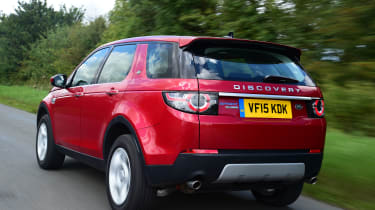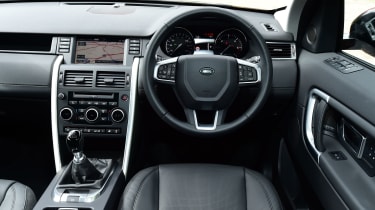New Land Rover Discovery Sport HSE 2015 review
New e-Capability model is greener, but at expense of brilliant auto and practicality

While the frugal e-Capability is slightly cheaper to run than other versions, the Discovery Sport is a premium package that works far better with the slick auto box. Ditching the rearmost seats also removes this Land Rover’s USP, so unless you’re a company car drIver dictated to by running costs, we’d go for the standard 178bhp Ingenium diesel with an auto, and sacrifice this pricey HSE trim. SE Tech is well equipped and only costs £20 more per year to tax.
We’re already familiar with Jaguar Land Rover’s brilliant new 178bhp 2.0-litre Ingenium diesel in the Land Rover Discovery Sport, as well as in the Jaguar XE. But to widen our Compact SUV of the Year’s customer base, particularly on the fleet market, a detuned 148bhp e-Capability model has been launched. We’ve driven it.
This car is designed purely to appeal to company car drivers looking for low tax bills and maximum fuel efficiency, so it has 50Nm less torque as well as 30bhp less power. But the e-Capability’s sacrifices extend beyond that.
To get CO2 emissions below 130g/km, Land Rover has had to cut weight, so it’s ditched the third row of seats. Lightweight 18-inch aluminium wheels wrapped in low-rolling-resistance tyres have been added, as has a six-speed manual gearbox in place of the slick nine-speed auto. Aside from the unique rims, the only obvious visual change is the blue Sport badge on the bootlid.
Used - available now

2023 Land Rover
Discovery Sport
31,281 milesAutomaticDiesel2.0L
Cash £28,800
2020 Land Rover
Discovery Sport
43,716 milesAutomaticDiesel2.0L
Cash £22,350
2021 Land Rover
Discovery Sport
44,202 milesAutomaticDiesel2.0L
Cash £24,220
2023 Land Rover
Discovery Sport
24,390 milesAutomaticDiesel2.0L
Cash £31,400The tweaks mean the e-Capability claims 57.7mpg economy and 129g/km emissions, beating the standard car’s 53.3mpg and 139g/km. So it’s one tax band lower, and down two Benefit in Kind percentage points (23 per cent vs 25 per cent).
However, in reality, the day-to-day cost advantages are likely to be small. What’s more, its efficiency is matched by the most frugal Mercedes GLC 220d – and that’s more than three seconds faster from 0-62mph.
From a standstill, the Discovery Sport never feels sluggish, but you soon realise you’re driving around using more throttle than you would in the more powerful car. Still, the clutch is light and the long-throw gearbox is precise and accurate.
Get up to speed, and this eco model is no less refined than the 178bhp version, feeling calm and composed at 30, 50 and 70mph. However, put your foot down in sixth, and where the auto swiftly drops a couple of gears, the manual is left trailing. The car picks up speed when you change down to fourth, but it all feels more laborious than in the slick-shifting auto.
Prices for the entry SE model start from £30,695, and all cars get four-wheel drive, making this the cheapest Discovery Sport on sale. However, at £35,395, our HSE begins to look expensive.
Standard kit includes the individual 18-inch alloys, an 11-speaker DAB stereo, leather seats and a swish panoramic roof, while interior quality is solid across the range – save for the slightly old-fashioned infotainment graphics.
Yes, it’s a top-spec model (HSE Luxury isn’t available on this eco version), but just £305 extra buys the more powerful 178bhp Discovery Sport in SE Tech trim with the brilliant nine-speed auto. When push comes to shove, that’s what we’d go for.











